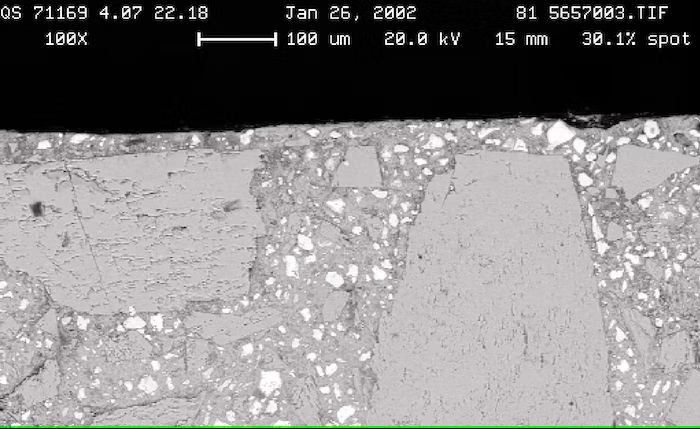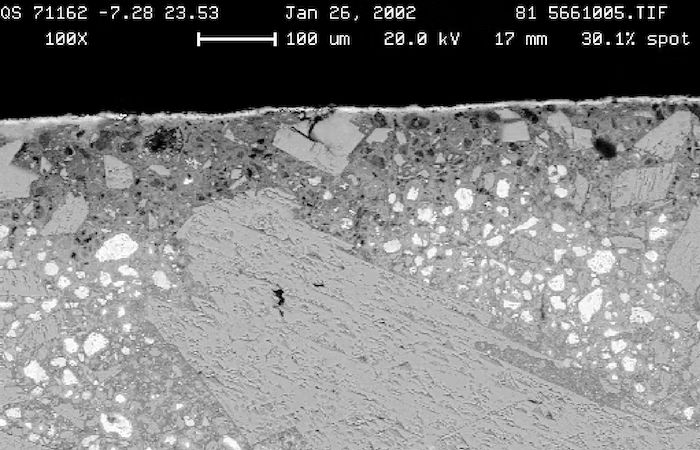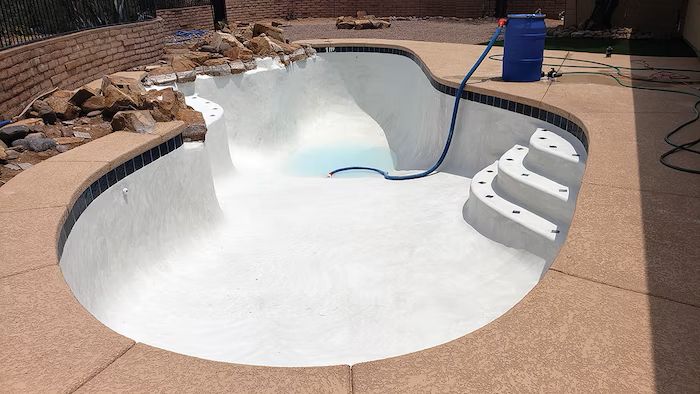The Best Plaster Pool Startup
March 4, 2023
Do you want the Best Plaster Pool Startup?
Reprinted with permission from Kim Skinner of OnBalance:
A good chemical pool startup is the beneficial and vital link between quality plastering workmanship and long-term water balance maintenance. A good startup helps preserve an attractive pool-plaster finish that will last for 20-plus years.
How a startup program deals with and prevents “plaster dust” from forming in newly plastered pools is the key.
Plaster “dust” is a calcium carbonate precipitate that usually forms when filling new pools, which then accumulates on the bottom of the pool. Many people believe the release of calcium from new plaster (which forms the “dust”) is natural and cannot be prevented.
That is incorrect. Plaster dust can be prevented altogether by filling newly plastered pools with water in the right Langelier Saturation Index (LSI) range, and following one other simple step, as explained in this article.
Plaster cross sections before filling and after filling.
Note the carbonation layer that forms on the plaster surface after it is filled — the very thin white line on top of the plaster surface.
UNDERSTANDING THE SCIENCE OF NEW PLASTER
Water that is balanced with an LSI of 0.0 is good for cured pool plaster. However, that same balanced water is detrimental to brand new plaster that is less than two to three weeks old, especially during the initial filling of new pools. This simple fact comes as a surprise to some who believe that perfectly balanced water (0.0 LSI) is always the goal.
The reason for this is that about 20% to 25% of hardened plaster (cement) is a byproduct material known as calcium hydroxide. That compound is relatively soluble and dissolves in 0.0 LSI balanced water during the first two to three weeks and leads to plaster dust formation and a compromised plaster surface.
It is that dissolution process that causes the pH to rise dramatically and to slowly convert into insoluble calcium carbonate, which then precipitates out of solution as plaster dust (calcium carbonate).
The fortunate and good news is that filling pools with water that has an LSI of +0.5 or above helps prevent calcium hydroxide from being dissolved from the plaster in the first place. Since the calcium hydroxide remains in the plaster, it can then be carbonated (converted) into the non-soluble and much harder calcium carbonate intact. That is known as the “carbonation process” which takes about two to three weeks.
When this startup is done properly, the result is a plaster surface that is harder, denser, smoother, and more stain-resistant.
The PROPER STARTUP STEPS:
1. Be patient with new plaster: The first important step is to not fill the pool immediately after final troweling. Wait a few hours (preferably four hours) to begin filling the pool. This will allow the fresh plaster in the deep-end bowl (which is troweled and finished last) to harden sufficiently before being submerged in water. Even positive LSI water will dissolve plaster material if it hasn’t been given enough time to harden (hydrate) sufficiently.
2. Fill with the best water: Ensure that the fill water has an LSI of about +0.5 with a minimum alkalinity of 120 ppm. If the tap or fill water doesn’t meet this standard, which is often the case with tap water in this country, it will be too late to balance the water after it has filled the pool. The improper source water will have already done damage by dissolving many pounds of calcium from the plaster. No startup program will undo that damage after the fact.
After waiting a few hours, and once the specially balanced tap water begins to fill the pool, fill as quickly and safely as possible. Any startup program that doesn’t require the two above conditions doesn’t provide the best care and protection for new plaster. As mentioned above, up to 40 pounds of calcium hydroxide can be dissolved and removed from plaster surfaces when the above steps are not followed, and this is why many plaster finishes, including quartz and pebble, often become unsightly in the few months that follow.
Research by onBalance indicates that the fill water should have a “combined” total of alkalinity and calcium content of at least 400 ppm minimum (which essentially achieves the required LSI of about +0.5) to prevent the dissolution of calcium hydroxide and the formation of plaster dust. (A combined total of 500 ppm is the ideal amount).
For example, if the fill water has an alkalinity of 80 ppm and a calcium hardness of 200 ppm, raise the alkalinity of the fill water to 200 ppm (prior to using it to fill the pool) to achieve a combined total of 400 ppm [200 ppm TA + 200 ppm CH = 400 ppm]. Having an alkalinity above 120 ppm should provide adequate pH buffering and helps prevent the pH from rising above 8.3.
When the above startup program is followed, there will be little or no plaster dust formation, the pH will be easier to keep and maintain below 8.2, and it will help retain a durable finish and preserve the vivid color in pigmented pool plaster. The Bicarb Startup (using sodium bicarbonate or baking soda to pre-condition the water) has been used successfully for over 40 years by many pool companies.
Do not pour undissolved bicarb directly into the pool. A 55-gallon barrel setup like the one shown here can help. With the required amount of bicarb already in the barrel, the hose delivers source water to the barrel’s lower inlet. The barrel fills and drains the solution into the pool from the upper outlet. When the pool is full, rinse in any remainder.
CALCIUM STARTUP
The Calcium Startup that Orenda Technologies promotes is a good startup program. It also appropriately recommends waiting a few hours before starting the filling process, along with adjusting the fill water to a positive LSI prior to entering the pool (similar to the onBalance program). The difference is that the Orenda program suggests raising the calcium hardness to a high level (by adding calcium chloride) to achieve a positive LSI instead of raising the alkalinity level.
1. A word of caution: The Calcium Startup is effective when the plaster quality is good. However, when the plaster quality is substandard, calcium hydroxide may bleed out, plaster dust may develop, and the pH of the water may rise above 8.3.
When the tap or fill water has a low alkalinity (less than 100 ppm), there may not be enough (pH) buffer strength to control and keep the pH down (below 8.3) when poor-quality plaster results in some calcium hydroxide releasing into the water. We suggest that the fill water have an alkalinity above 120 ppm to provide sufficient pH buffering due to this possibility. Note: Adding calcium chloride does not provide pH buffering strength.
2. A note about plaster quality: While it is true that a poor pool startup can ruin a high-quality plaster finish, especially an acid startup, it is equally true that poor-quality pool plaster and workmanship will negate a good startup program, or in other words, a good startup process cannot fix bad plastering.
Poor-quality plaster and workmanship can result in the loss of some calcium hydroxide and calcium chloride from the plaster regardless of the startup program. Any loss of plaster material results in greater plaster porosity.
In addition, poor-quality plaster can result in excessive craze cracking, graying mottling of white plaster, plaster turning whitish in streaks, spots and blotchiness, color fading, calcium nodules, and even some plaster dust. Plastering mistakes that lead to these problems involve excessive water-to-cement ratio, excessive calcium chloride additive, excessive water troweling, and too early filling. A good startup program cannot prevent or alleviate those plaster defects, nor does aggressive water cause any of the listed issues.
Poor chemical startups and poor long-term maintenance cause problems such as uniform calcium scaling or uniform etching throughout a pool, and localized damage where non-diluted chemicals come into direct contact with the plaster surface.
Details on how to do a Bicarb Startup can be found here.
GOOD TAP WATER
In some areas of the country, the tap water already has a positive LSI with sufficient levels of alkalinity and calcium (combined total of at least 400+ ppm) and can be simply used, as is, to fill new plaster pools without having to do any chemical additions with bicarb or calcium. If that is the case, thank your lucky stars. There will be no need to do a special water compounding program. However, the only way to know is to, as we constantly emphasize, test the water before filling the pool.
Reprinted with permission from Kim Skinner of OnBalance




